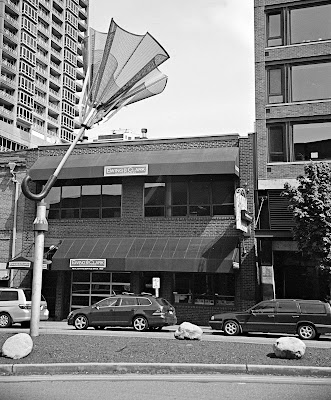





METHOD.
Film Ilford Legacy 400 ASA. Film exposed at 400 ASA.
Camera was a Nikon F90X. The exposure method was 'manual' using 'matrix' metering. The lens was a Sigma 28 - 200. My 'standard' working temperature is <> 22 deg C. My film developing tank sits in a thermostatically controlled water bath. The developing chemicals are also in this water bath. My 'film tank' is a paterson 'twiddle stick' type with plastic film reel holders. But my
method should work with s/steel tanks also. By also keeping the water for the chemicals in the water bath I can and do mix the two separate solutions just before I process.NO pre-soaking is used.
Stock Solution 'A'' = Ascorbic acid 1g. Catechol 10g. Propylene glycol 100ml.
Stock Solution 'B' = Sodium Hydroxide 10 grams in 100ml of filtered water.
Hypercat 2 Bath Process. Solution 'A'. 30ml in 300ml filtered water. Solution 'B'. 30ml in 300ml filtered water.
Times are. Solution 'A' = 6'. Then drain off (I prefer to use my developers as one-shot as the mixed solutions have a short usage life).
Pour in solution 'B' and develop for 6'. Contrary to normal 2 bath procedure I agitage in 'Both' baths.
When you dump solution 'B' it will have some discolouration.
Agitation sequence for both baths: Initial 30" then 10" (approximately 4 twists of the stick, alternating the direction) every minute.
Agitation = 30" - 1'30" - 2' 30" - 3' 30" - 4' 30" - 5' 30". That means I give a final agitation 30" before I dump the chemicals.
I use two plain filtered water stop baths of 30" each
I use a Rapid fix for 2' followed by washing for 10' (this is from my sink tap so the temperature is going to be below the fixing temperature. I have not noticed any film problems using this method during the summer here in the U.K. In the winter I would use water stored in my darkroom and give probably 10 changes of water using constant agitation as described by Ilford to save water).
I finish-off with a 1' soak in filtered water with a couple of drops of 'Dishwasher Detergent' added. Drying by hanging the strip in my darkroom.
I have an LPL C7700 colour head enlarger. When I started printing monochrome negatives only, using my colour head filtration. I was never very happy with the results. They were OK, but just OK. I tried the under the lens filters and things improved. I thought there was a problem with the filtration. So that is how I used to print using these U/Lens filters. However. When I got interested with stained negatives things started to go wrong, quality wise. As I said in my previous email my prints always looked flat. So I started experimenting with different tanning developers including Windisch and DiXactol. Always looking for the 'magic bullet'.
I purchased an R. H. Designs 'Analyser Pro'. Once calibrated this gives me a Time/Grade suggestion readout as well as a 'greyscale' guide. It does not do anything to the enlarger except switch it on or off. You have to manually set the suggested filter grade. Things improved again enough to make me think I had arrived at my best shot! However then came 510 Pyro and Hypercat! These developers seemed to behave differently to the other staining developers I had previously tried. They were both simpler to formulate, had very good storage times, and of course they were very cost effective.
This when I started to contact you. You will be aware of the questions/answers in the various emails. To cut a long story short today, after completing a short series of printing tests with single filters in my colour head on MG IV paper I have found my 'magic bullet' (I think).
I found that when using a Hypercat developed negative that gave a suggested grade 2 and specific time on the analyser. Ilford recommend '0' filtration for this grade, all I had to do was add + 5 magenta filtration in my colour head. This minute variation from my previous attempts resulted in prints that were no longer 'flat' in appearance and had lovely contrast.
So impressed was I that this morning I used Hypercat 2 Bath (30ml/300 A and 30ml/300 B) to process a valuable film I exposed last week at a 'National Trust' stately home garden here in the UK. The negatives have tremendous stain, which concerened me at first. But when I printed a couple of them, to say I was delighted with the results is an understatement.
I have attached three negatives and three scans of the resulting prints, the prints actually look much better than the scans suggest. These results, after very many hours of frustrated testing, has renewed my enthusiasm, and for that I have to thank you. I have not modified the images in any way, other than to reduce their resolution and size to send them to you.Negatives from each process were scanned using my Epson Perfection 4490 flatbed scanner in 'transparency' mode. I had to scan the negatives as 'Slides' and then convert them into grescale using computer software. This due to the stain confusing the scanner, when monochrome scanning is selected.It is nice to be able to contribute to your web site Jay, rather than just learning from it.
I appreciate that 'tanned' negatives are not to everyones liking. But I now have standardised on Hypercat and 510 Pyro. I feel that other developers I have mixed, including 'Quick Clear Rodinal', will stay in their bottles on the shelf.
All the best.
Dennis


